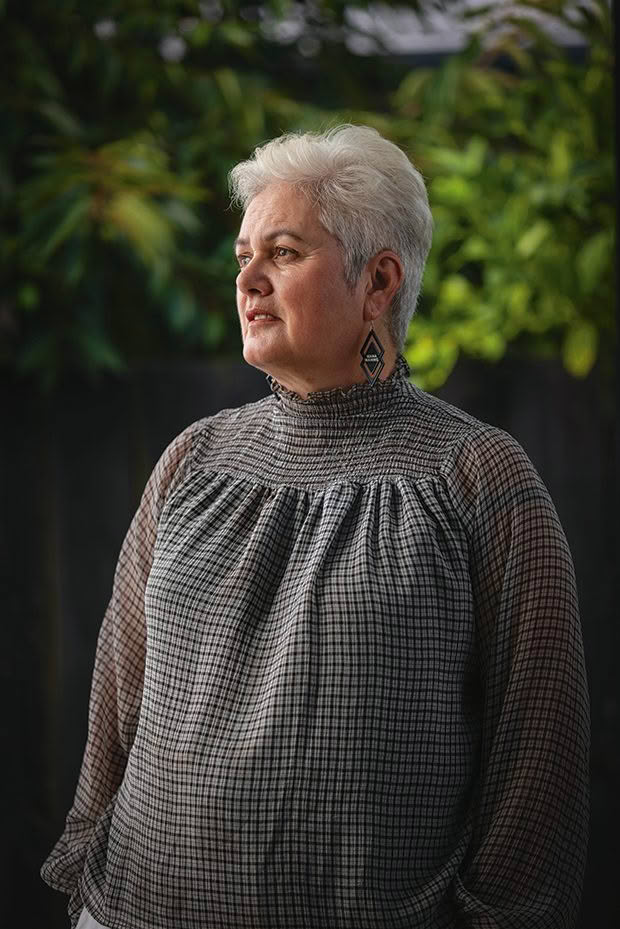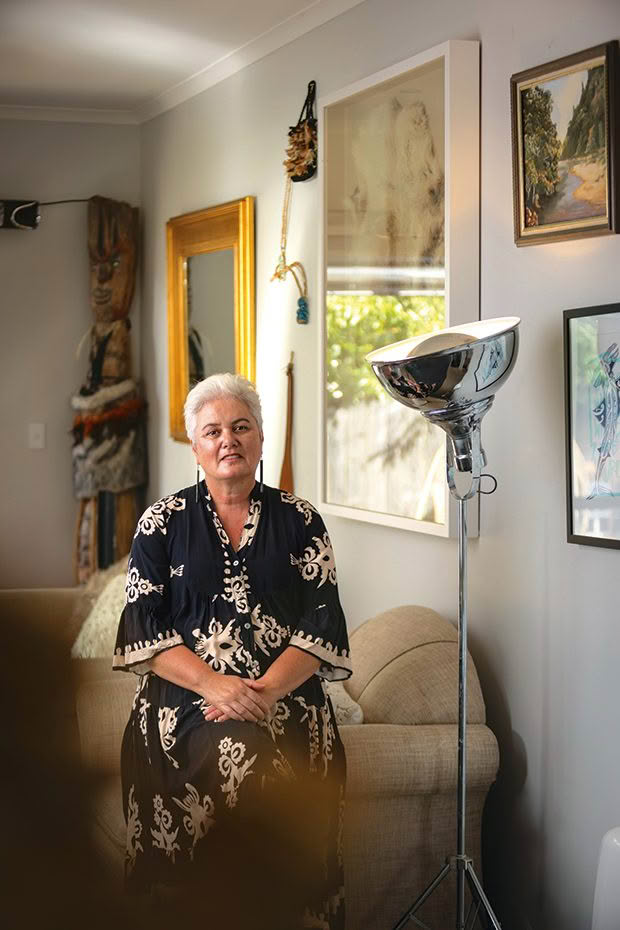Michelle Wilson is putting community into leadership

Michelle Wilson’s diverse upbringing, from urban Ōtara to rural Kaiaua, offers a unique lens on community, culture and leadership.
Words: Amokura Panoho Photos: Tessa Chrisp
PEPEHA
Ko Kohukohunui te maunga
Ko Tīkapa te moana
Ko Kōtuiti tuarua te waka
Ko Wharekawa te marae
Ko Ngāti Pāoa, Ngāti Whānaunga,
Ngāti Tamaterā, Ngāti Maru ōku iwi
Pare Hauraki, Pare Waikato
Tihei mauri ora!
Kokokohunui is my mountain
Tīkapa my ocean
Kōtuiti Tuarua my ancestral canoe
Wharekawa my marae
Ngāti Pāoa, Ngāti Whānaunga, Ngāti
Tamaterā, and Ngāti Maru are my iwi
They reside within the regions of
Hauraki and Waikato
My life force is alive!
WHAT IS YOUR CURRENT ROLE?
My background in project management, health research and community activations includes the development of the Āwhitu Food and Wine Festival in 1999. I managed that event and later supported the Hauraki Collective Treaty Settlement, initiated in 2009.
In 2012, I joined the Auckland Council Southern Initiative, where I was part of a team tackling South Auckland’s social and economic challenges. From there, I moved into another strategic role within the council, supporting marae developments across the city.
Two years ago, I was honoured to become the inaugural chief executive of our iwi, Ngāti Tamaterā. I am deeply conscious of the duties and expectations of this role. With the guidance of mentors and role models — and whānau support instrumental in preparing me — I am eager to contribute to our community.
WHO AND WHAT HAVE BEEN THE MOST FORMATIVE INFLUENCES IN YOUR LIFE?
Fortunately, my parents — one Māori and one Pākehā — demonstrated what working together looked like. My parents worked full time, and with a growing family, they sent their children from Ōtara to live with Mum’s mother, Kahupeka Te Waero, in Kaiaua until their youngest, me, turned five. Then we moved to Meremere, where they worked on the new power station and the dam at Mangatangi.
We often travelled from the quietness of these rural communities to the hustle and bustle of Ōtara, South Auckland. At the time, Ōtara was becoming the home of many Pasifika families, and we enjoyed their community spirit and learning about their culture. I loved going to my new friends’ houses and learning to make lei, necklaces made from tropical flowers and leaves.
My mother, Te Aomarama Wilson nee Te Aho Thompson, was hugely influential and active in our Ōtara community and her own in Kaiaua and at her marae, Wharekawa.
Mum and other community stalwarts such as Aunty Aggie Theodore epitomised the importance of connections in their behaviour and community activities. Our family was also one of the early supporters of the Ōtara Flea Market in 1976, waking up early every Saturday morning to boil pork bones, puha and watercress for the 6am breakfast rush at the Puke Ōtara Kitchen.
My older brother, Morehu Anthony Wilson, was also a great influence. He went to St Stephen’s School in Bombay, and we siblings often considered him the “golden child”. But, even early on, he demonstrated a quiet style of leadership that came to the fore in 2010 when he became a negotiator for Ngāti Pāoa, part of the Hauraki collective iwi claim, which also included Ngāti Maru, Ngāti Tamaterā, Ngāti Tara Tokanui and Te Patukirikiri.
He often said to me, “Don’t do too much. Slow down and focus on doing things well.” He was selfless, giving much of himself to the claims process, sometimes to the detriment of quality time with his family and health. Sadly, we lost him to motor neurone disease in 2022.
Our mother was also the mokopuna of Kupenga Te Waero, an apōtoro (minister) for the Rātana Church. As children, we sang in the local choir, and I gained confidence in front of an audience.
Visits to the Rātana village just out of Whanganui for events were yearly family outings, exposing us to a broader Māori community and identity. I am pleased that my children have reactivated that association and are raising my mokopuna within our haahi (faith).
WHAT DOES THE CALL TO LEADERSHIP MEAN TO YOU?
Community development projects and rangatahi programmes have been the cornerstone of my career, seeing what talent exists within a community and finding platforms to showcase and support their growth and development.
The Āwhitu Festival idea happened after I’d been to a community meeting with my young family while living there. The meeting was about looking at ways to generate opportunities for the local economy, and I saw all this tremendous artistic talent.
Given the proximity to Auckland, why not create a festival? So that’s what we did, and it became a go-to event for Aucklanders wanting something different to do for the day. We even managed to organise a ferry service from Cornwallis, West Auckland, to Ōrua Bay.
To me, that is leadership: focusing on the good that might happen, finding ways to enhance that, and doing rather than talking. I saw it as blending cultural celebration with economic opportunity.

WHAT ARE THE GOALS FOR YOUR PEOPLE?
Sustainable development, cultural education and the empowerment of iwi Māori. I believe in the active expression of our mana motuhake.
Though it has become a politically charged term, especially under this present coalition government, it doesn’t have to be.
It can mean self-respect earned by our actions. That’s why I advocate for regenerative and sustainable practices. I am passionate about protecting the health of our freshwater ways through Te Mana o Te Wai and Te Oranga o te Taiao. That enables tikanga Māori (traditional practices) to be recognised in natural and built environments as part of our country’s resource management.
Central to any tribal leadership is the role of Te Tiriti o Waitangi, a cornerstone strategic approach to governance and community development. Te Tiriti is not just an historical document; it’s a living guide that shapes our journey as a nation and as individual iwi. To tamper with its legitimacy is foolish.
HOW WILL THESE ASPIRATIONS BE ACHIEVED?
The journey post-settlement is about building and moving forward with a clear vision for our tamariki and mokopuna. Thechallenges range from economic development to maintaining cultural integrity, but I am approaching them from a blend of traditional wisdom and modern strategy.
Our present focus is on re-establishing our visibility as an iwi within an environment with many overlapping areas of interest with our neighbouring iwi. We are small in size and population, but within our rohe (region), we are party to several significant arrangements that allow us to be seen and heard.
My aim is is to consolidate the authority of Ngāti Tamaterā so we can build a legacy and platform. My first approach is about being able to tell our stories and affirm whakapapa connections to our tūpuna (people) and place.
This will emphasise community engagement and empowerment, cultural preservation, economic development, education and training, environmental stewardship, political advocacy, strategic partnerships, innovation and adaptation. These approaches need a strong rangatahi interface to ensure we are taking our people on this journey.
YOUR ADVICE FOR INTERESTED READERS?
Engage with your local communities, understand the historical and cultural contexts of the iwi and hapū and contribute positively to shared goals. It’s about partnership, understanding and respect. We can build a future honouring our collective past while forging a prosperous, inclusive future.
NGĀTI TAMATERĀ SETTLEMENT
The treaty settlement process for Ngāti Tamaterā, as part of the Hauraki Collective, also involved negotiations with the Crown, leading to the acquisition of the Pouarua Dairy Complex. The Crown agreed to make a payment on account of the Pare Hauraki collective deed, enabling the entity, representing five of the iwi of Hauraki, to purchase the complex.
Returned in 2013 in the largest on-account treaty settlement ever made by the Crown, Pouarua Farms is now jointly owned by Ngāti Tamaterā under a limited partnership agreement with Ngāti Maru, Ngāti Paoa, Ngāti Tara Tokanui and Te Patukirikiri. The farms lie within the Māori land blocks known as Ngarua, Waitakaruru and Puhangateuru, located on the Hauraki Plains, 35 kilometres southeast of the Bombay Hills. The 2200-hectare platform comprises 10 farms: nine dairy units and one drystock unit. This is the largest single dairy platform in the Hauraki region. Some 4600 cows are milked across 1775 hectares, producing about 1.65 million kilogrammes of milk solids.
The Hauraki Collective settlement also outlines a comprehensive framework for the appointment and operation of hearing commissioners in relation to resource consent applications, particularly in the waterways of the Waihou Piako and Coromandel catchments.
Ngāti Tamaterā also have interests in the Tāmaki and Marutūāhu Collective Deeds of Settlement.
 This article first appeared in NZ Life & Leisure Magazine.
This article first appeared in NZ Life & Leisure Magazine.
